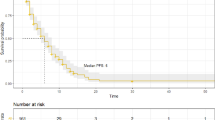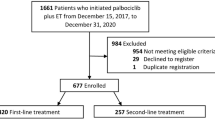Abstract
Background
Definitive radiotherapy and vismodegib, an oral inhibitor of the hedgehog pathway, are both established treatment options for locally advanced basal cell carcinomas (BCC). Both have shown good results in local tumor control; however, the effects concerning advanced tumors are often not of a lasting nature and to date no systematic data about the combination of the two modalities are available.
Patients and methods
We retrospectively analyzed four patients who received vismodegib and radiotherapy in combination. Radiation doses varied between 50.4 Gy and 66.0 Gy. Three patients had recurrent BCC. One patient had locoregional lymph node involvement. Vismodegib was taken once a day (150 mg) during the entire time of irradiation and beyond upon instructions of the attending dermatologist.
Results
In three cases a persistent complete response was observed, in one case the tumor remained stable for approximately 6 months until further tumor progression was documented. The combined therapy was well tolerated in all cases. No exceptional side effects pointing at a drug–radiation interaction were observed.
Conclusion
The combination of vismodegib and radiation seems feasible and the initial results are promising. In our cohort, there was no increase in unexpected side effects. Further research is needed to evaluate the significance of this combined therapy.
Zusammenfassung
Hintergrund
Sowohl definitive Radiotherapie als auch Vismodegib, ein oraler Inhibitor der Hedgehog-Signalkaskade, sind etablierte Behandlungsoptionen für lokal fortgeschrittene Basalzellkarzinome (BCC). Beide Therapien zeigen für sich gute Ansprechraten, aber die lokale Tumorkontrolle ist oft nicht dauerhaft und bis heute existieren kaum Daten über eine Kombination der beiden Modalitäten.
Patienten und Methoden
Wir analysierten retrospektiv vier Patientenfälle nach simultaner Applikation von Vismodegib und Bestrahlung. Die Bestrahlungsdosis variierte zwischen 50,4 Gy und 66,0 Gy. Drei der Patienten hatten ein rezidiviertes BCC. Ein Patient hatte einen befallenen regionalen Lymphknoten. Vismodegib wurde einmal täglich (150 mg) über die gesamte Radiotherapie und nach deren Beendigung, je nach Empfehlung des betreuenden Dermatologen, eingenommen.
Ergebnisse
In drei Fällen konnte ein länger andauerndes Ansprechen beobachtet werden. In einem Fall verblieb der Tumor für 6 Monate stabil, bevor eine erneute Tumorprogression festgestellt werden konnte. Die kombinierte Therapie wurde in allen Fällen gut vertragen. Es konnten keine unerwarteten Nebenwirkungen beobachtet werden, die auf eine supraadditive Toxizität deuten könnten.
Schlussfolgerung
Die Kombination von Vismodegib und Radiotherapie erscheint möglich. Die ersten Ergebnisse sind vielversprechend. In unserer Kohorte konnte keine erhöhte Toxizität beobachtet werden. Künftige Studien sollten den Stellenwert dieser kombinierten Therapie untersuchen.



Similar content being viewed by others
References
Lear JT, Smith AG (1997) Basal cell carcinoma. Postgrad Med J 73:538–542
Nongrum HB, Bhuyan D, Royte V et al (2014) Metastatic basal cell carcinoma to the lungs: case report and review of literature. Indian Dermatol Online J 5:S26–S29
Hernandez-Machin B, Borrego L, Gil-Garcia M et al (2007) Office-based radiation therapy for cutaneous carcinoma: evaluation of 710 treatments. Int J Dermatol 46:453–459
Olschewski T, Bajor K, Lang B et al (n d) [Radiotherapy of basal cell carcinoma of the face and head: importance of low dose per fraction on long-term outcome]. J Dtsch Dermatol Ges 4:124–130
Schulte KW, Lippold A, Auras C et al (2005) Soft x-ray therapy for cutaneous basal cell and squamous cell carcinomas. J Am Acad Dermatol 53:993–1001
Locke J, Karimpour S, Young G et al (2001) Radiotherapy for epithelial skin cancer. Int J Radiat Oncol Biol Phys 51:748–755
Lovett RD, Perez CA, Shapiro SJ et al (1990) External irradiation of epithelial skin cancer. Int J Radiat Oncol Biol Phys 19:235–242
Fitzpatrick PJ (1984) Skin cancer of the head—treatment by radiotherapy. J Otolaryngol 13:261–266
Sekulic A, Migden MR, Lewis K et al (2015) Pivotal ERIVANCE basal cell carcinoma (BCC) study: 12-month update of efficacy and safety of vismodegib in advanced BCC. J Am Acad Dermatol 72:1021–1026e8
Cirrone F, Harris CS (2012) Vismodegib and the hedgehog pathway: a new treatment for basal cell carcinoma. Clin Ther 34:2039–2050
Proctor AE, Thompson LA, O’Bryant CL (2014) Vismodegib: an inhibitor of the Hedgehog signaling pathway in the treatment of basal cell carcinoma. Ann Pharmacother 48:99–106
Yang L, Xie G, Fan Q et al (2010) Activation of the hedgehog-signaling pathway in human cancer and the clinical implications. Oncogene 29:469–481
Sims-Mourtada J, Izzo JG, Apisarnthanarax S et al (2006) Hedgehog: an attribute to tumor regrowth after chemoradiotherapy and a target to improve radiation response. Clin Cancer Res 12:6565–6572
Zeng J, Aziz K, Chettiar ST et al (2013) Hedgehog pathway inhibition radiosensitizes non-small cell lung cancers. Int J Radiat Oncol Biol Phys 86:143–149
Chung CH, Dignam JJ, Hammond ME et al (2011) Glioma-associated oncogene family zinc finger 1 expression and metastasis in patients with head and neck squamous cell carcinoma treated with radiation therapy (RTOG 9003). J Clin Oncol 29:1326–1334
Chaudary N, Pintilie M, Hedley D et al (2012) Hedgehog pathway signaling in cervical carcinoma and outcome after chemoradiation. Cancer 118:3105–3115
Yoshikawa R, Tsujimura T, Tao L et al (2012) The oncoprotein and stem cell renewal factor BMI1 associates with poor clinical outcome in oesophageal cancer patients undergoing preoperative chemoradiotherapy. BMC Cancer 12:461
Pollom EL, Bui TT, Chang AL et al (2015) Concurrent vismodegib and radiotherapy for recurrent, advanced basal cell carcinoma. JAMA Dermatol. doi:10.1001/jamadermatol.2015.0326
Raleigh DR, Algazi A, Arron ST et al (2015) Induction Hedgehog pathway inhibition followed by combined modality radiotherapy for basal cell carcinoma. Br J Dermatol. doi:10.1111/bjd.13748
Bonner JA, Harari PM, Giralt J et al (2006) Radiotherapy plus cetuximab for squamous-cell carcinoma of the head and neck. N Engl J Med 354:567–578
Schulze B, Meissner M, Wolter M et al (2014) Unusual acute and delayed skin reactions during and after whole-brain radiotherapy in combination with the BRAF inhibitor vemurafenib. Two case reports. Strahlenther Onkol 190:229–232
Hecht M, Zimmer L, Loquai C et al (2015) Radiosensitization by BRAF inhibitor therapy-mechanism and frequency of toxicity in melanoma patients. Ann Oncol 26:1238–1244
Lee IJ, Koom WS, Lee CG et al (2009) Risk factors and dose-effect relationship for mandibular osteoradionecrosis in oral and oropharyngeal cancer patients. Int J Radiat Oncol Biol Phys 75:1084–1091
Sekulic A, Migden MR, Oro AE et al (2012) Efficacy and safety of vismodegib in advanced basal-cell carcinoma. N Engl J Med 366:2171–2179
Tang JY, Mackay-Wiggan JM, Aszterbaum M et al (2012) Inhibiting the hedgehog pathway in patients with the basal-cell nevus syndrome. N Engl J Med 366:2180–2188
Basset-Seguin N, Hauschild A, Grob JJ et al (2015) Vismodegib in patients with advanced basal cell carcinoma (STEVIE): a pre-planned interim analysis of an international, open-label trial. Lancet Oncol 16:729–736
Author information
Authors and Affiliations
Corresponding author
Ethics declarations
Conflict of interest
B. Schulze, M. Meissner, S. Ghanaati, I. Burck, C. Rödel, and P. Balermpas state that there are no conflicts of interest.
All studies on humans described in the present manuscript were carried out in accordance with national law and the Helsinki Declaration of 1975 (in its current, revised form). Informed consent was obtained from all patients included in studies. Consent was obtained from all patients identifiable from images or other information within the manuscript. No underage patients were included.
Rights and permissions
About this article
Cite this article
Schulze, B., Meissner, M., Ghanaati, S. et al. Hedgehog pathway inhibitor in combination with radiation therapy for basal cell carcinomas of the head and neck. Strahlenther Onkol 192, 25–31 (2016). https://doi.org/10.1007/s00066-015-0902-7
Received:
Accepted:
Published:
Issue Date:
DOI: https://doi.org/10.1007/s00066-015-0902-7




